Table of Contents
Ranked Draft Core Set 2019 is available on MTG Arena for a week between March 27 2020 at 8:00 AM PST to April 3 2020 at 8:00 AM PST as part of the Historic season! I may be in the minority here, but I absolutely love drafting Core Sets. Some people look down on them because they are more ‘beginner friendly’ and have an overall lower power level, but for me that just means they get back to the fundamentals of Magic. There are only a handful of bombs in this set, so many games are decided by intelligent attacks/blocks and more often than not the deck that has more synergy and can create more small advantages over time ends up winning. There is a lot of reward in not only drafting strong cards, but understanding the different archetypes at play so that you can get the most out of them. So in this overview I will be identifying the archetypes, discussing how they fit into the format as a whole, and I will be creating ‘starter packs’ for each archetype that identify the best commons and uncommons for each.
The M19 Format
- There are few Bombs – you will usually need to build your deck around powerful uncommon cards.
- Removal is average – this makes for a balanced format.
- Evasive creatures are less common – drafting these early is crucial for certain decks.
- Creatures are weak – this is normal for core sets and bad for aggro.
- The format is slow – this is bad for aggro decks, but Boros can still pull off lethal very fast with certain cards.
In any core set especially, it is important to keep the BREAD acronym in mind: prioritize Bombs, then Removal, then Evasive creatures, then Attacking creatures, and then draft the duds as filler if you must. Since there are few bombs, removal and evasion are at a premium. All color pairs have a dual land in M19, so the possibilities can be overwhelming. Keep in mind that it is generally good to pair a color that has good removal spells with a color that has strong creatures. 3-color is not a good option in M19 unless you are building around an Elder Dragon mythic rare. So, let’s look at the different color pairs and I will highlight a particular card to represent the theme of each archetype.
M19 Archetypes
Aggro Decks: Rakdos (BR), Izzet (UR), and Boros (RW)



Of the three, I would advise not to draft Rakdos. The problem with the deck comes down to card advantage. If you do not deal lethal by turn 6 or so, your odds of winning are extremely low. While Rakdos packs good removal, its creatures are extremely easy to outclass. Even though Brawl-Bash Ogre has menace and is a strong card, there are very few additional evasive creatures to compliment him with.
Izzet (Spells): Izzet plays best as a spell-heavy tempo deck. I am putting it in the aggro section because it has certain payoff/enablers that can end the game very fast if they go unanswered. I think Izzet has a very high ceiling and with the right cards is one of the best archetypes in the format.
Boros (Aggro): Boros is the purest aggro deck in M19. The game plan is to flood the board with low cost creatures and then get extra value out of them. Heroic Reinforcements is the best card in this deck and really exemplifies what it is trying to do. I have had several 7-x decks with this archetype and think it is one of the better ones.
Midrange Decks: Gruul (RG), Golgari (GB), Orzhov (BW), Selesnya (GW), and Simic (UG)
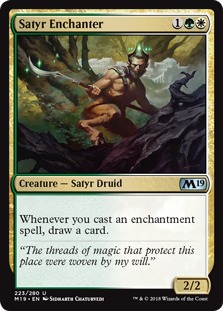


Gruul (Ramp): This deck is bread-and-butter limited. Green supplies mana ramp and strong high-curve creatures while Red contributes removal and low-curve creatures. This archetype is tied pretty strongly to the power level of the creatures you are able to draft, so I think overall Gruul is an average archetype in M19.
Combo Decks: Orzhov (Life gain) and Selesnya (Enchantments)
Both of these decks are viable, but Orzhov life gain has a higher ceiling and I think is the better deck. There are multiple payoffs and enablers for gaining life in Black and White, so you are more likely to find the cards you need and I have had several successful Orzhov decks in M19. At the same time, I have gone 7-x with strong Selesnya decks. Pegasus Courier becomes very powerful when it can lift up strong green creatures, and getting extra value out of the Luminous Bonds you were happy to play anyway feels great. The downside is that you may include enchantment spells that don’t contribute enough to win if you don’t find the payoff cards. I will go into more depth on my upcoming ‘starter pack’ articles on each of these decks.
Unfocused decks: Golgari and Simic
Unfortunately, I do not think these colors are very good together. This may be surprising because Poison-Tip Archer and Skyrider Patrol are both fantastic cards. While you may be able to pick up copies of these along with other strong cards in the colors to create solid Golgari/Simic decks, I do not think there is much synergy within each archetype and they have glaring weaknesses. For Golgari, you are very susceptible to flying and have very few ways to generate card advantage. For Simic, you have card advantage and can ramp into good creatures, but you have almost no removal. The removal you do have is fight/enchantment based which has a lot of downside. I think you would be better off avoiding these archetypes and won’t be writing starter pack guides for them.
Even though I said earlier that 3-color was to be avoided in M19 limited, cards like Palladia-Mors are worth a splash without a doubt. Palladia in particular would be a great addition to GR Ramp deck and goes great with Draconic Disciple.
Control Archetypes: Azorius (UW) and Dimir (UB)


Both of these decks can be quite strong, mostly because Blue is very powerful in M19. There are many great playables at common and uncommon which makes Blue a smart color to be in. Whether you add White or Black (or Red) just depends on your card pool.
Azorius (Flyers and Artifacts): Adding white gets you access to flying creatures and an interesting artifact sub-theme in addition to the removal. Going down the artifact road can be very hit or miss. If you pick up the right cards it can be one of the strongest decks, but if they don’t come your deck can end up very unfocused.
Dimir (Control): Adding black gets you a great removal suite and firmly puts you in the control archetype. Psychic Symbiont is a great avatar for this deck (and an incredible 3-for-1). The game plan is to generate card advantage and answer all of your opponents threats, eventually winning with powerful flyers (or efficient creatures) once they run out of steam.
Guild Standings in M19
- Aggro: Boros, Izzet,
Rakdos - Midrange/Combo: Gruul, Orzhov, Selesnya,
Golgari,Simic - Control: Azorius, Dimir
All of the remaining 7 decks are viable and can be great with the right cards, and remember:
Other Decks Are Possible!
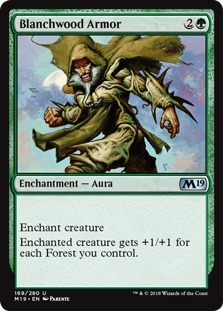
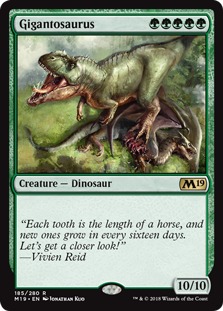

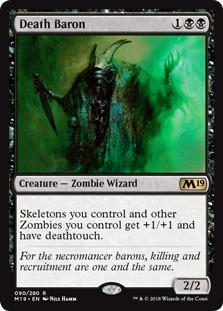
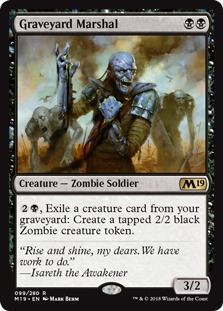
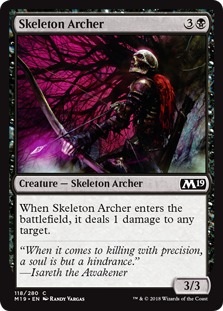
There are several rares that open up some interesting synergy if you see them. Have I drafted a 7-0 mono green deck with Gigantosaurus, Goreclaw, and multiple Blanchwood Armor? Yes, and it was awesome. Is it really fun (and effective) to turn Skeleton Archers into 3/3 Ravenous Chupacabras with Death Baron? Absolutely! But once again due to the fact that you only see about 3 rares/mythics per draft it is much more valuable to spend time discussing commons/uncommons. So in the next section I will be breaking down ‘starter packs’ that go into more depth on each archetype.
Boros (RW) Starter Pack
Boros is the most apparent aggro deck in a format where aggro doesn’t work so well. But, assemble enough of the cards below and you have quite possibly the best possible deck in M19 limited. This is primarily because most of your opponents are going to expect a slow match and will often keep hands that are woefully unprepared for the curve-out blow-out that this archetype is capable of.
Best Uncommons

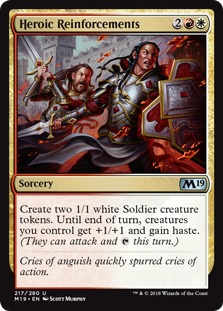

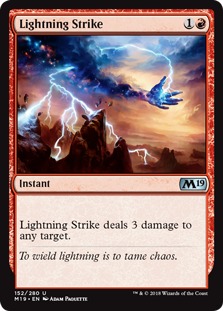
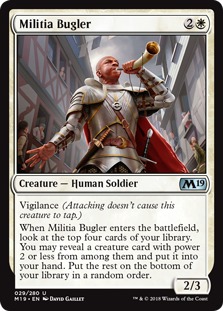

In this deck we want cheap creatures and removal. Heroic Reinforcements is the best card here and you should never ever pass it. Hieromancer’s Cage and Herald of Faith are a bit expensive, but still well worth taking. Militia Bugler is usually going to find a friend (or two) in this deck, and Volley Veteran is a strong creature and removal, so that’s pretty sweet!
Best Commons
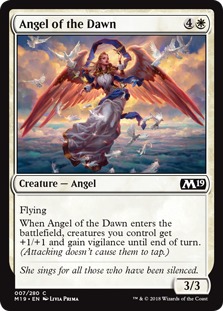
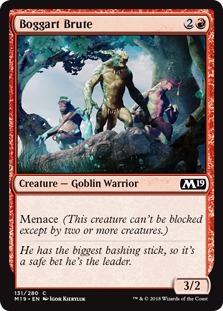
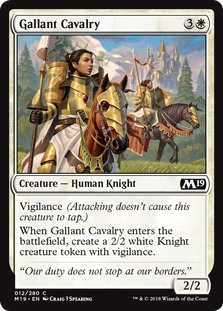
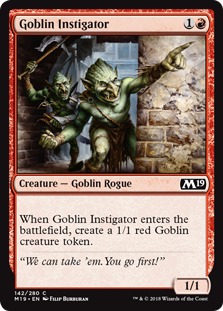

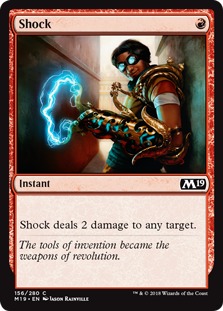


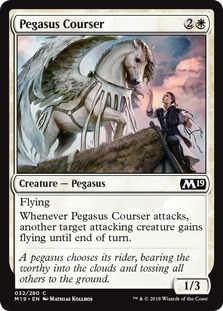
Luminous Bonds is going to be your first priority at common in any white deck. After that you should be thinking about Pegasus Courser, Star-Crowned Stag, and Angel of the Dawn. The first two provide precious evasion for your other creatures, and while Angel of the Dawn might seem expensive, you will understand its power when it boosts several of your creatures. It is no slouch at 3/3 flyer status on your following turn, and the vigilance it provides can often decide the game, so don’t forget about that. Goblin Instigator and Gallant Cavalry are the backbone of Boros in M19, each giving you two creatures at once. Boggart Brute and Sure Strike are the weakest cards on this list, but I am happy to draft both of them. Menace is important in this format, and Sure Strike is a powerful combat trick. This is typically a 17 creature deck (and some of them will be 2-for-1), so the chances of drawing it with no targets is quite low.
Izzet (UR) Starter Pack
Izzet is another aggressive deck I am happy to draft in M19. There is a lot of great synergy to be had, specifically by playing many instants and sorcery spells and fewer creatures. Due to the abundance of card advantage Blue brings, this deck can be played as more of a midrange or even control archetype if the right cards present themselves. So, I would consider Boros the only ‘true’ aggro deck in M19.
Best Uncommons


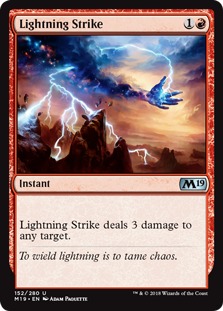

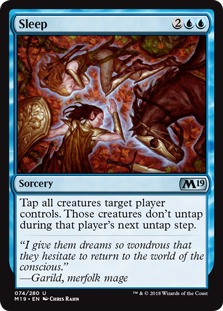

Guttersnipe/Enigma Drakes are wonderful build-arounds for this archetype. Blue and Red both have several powerful spells and these cards are a great way to get additional value out of them. Lightning Bolt, Sift, and Sleep are the most powerful uncommon spells these colors have to offer and are some of the best cards in the entire set. Exclusion Mage epitomizes the tempo nature of this deck. The game plan is often establishing some creatures early and using removal/evasion to get them through until your opponent runs out of hit points. Departed Deckhand is an honorary mention that is completely on theme for this archetype.
Best Commons



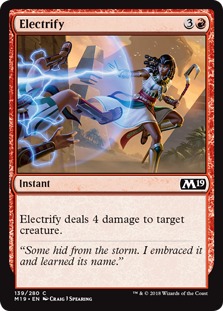
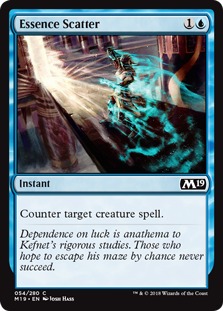



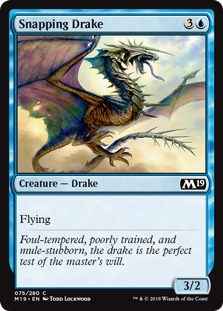
Yeah, Blue has a lot of fantastic commons which is why it is probably the best color in M19 limited. Red chips in a couple removal spells, but Blue carries this deck with evasive creatures, card advantage, and great synergy between its creatures and instant/sorcery heavy decks. Salvager of Secrets is great at the top of your curve as long as you’ve drafted some nice targets to recycle (i.e. the three uncommon spells above or a nice rare).
Gruul (GR) Ramp
This deck utilizes mana dorks to drop large threats onto the board quickly. Red contributes removal and low-curve threats depending on how aggressive you want your deck to be. The significant drawback to playing this archetype is you will not be able to gain card advantage except for a couple powerful tricks I will be going over. This means you will find yourself in a lot of ‘top deck’ situations when you draft this, and taking aggressive mulligans is very important.
Best Uncommons
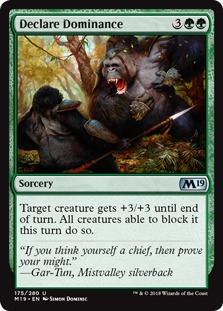




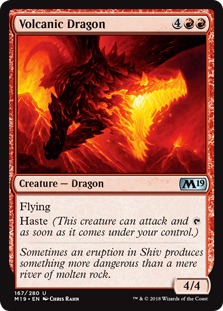
Draconic Disciple is a solid card. Usually he just taps for mana and helps enable double costed cards (i.e. most of the other cards shown here). However, the 7 mana ability is relevant more often than you’d expect in a ramp deck and I like that it makes getting mana flood more palatable. Vigilant Baloth, Vine Mare, and Volcanic Dragon are all powerful creatures to take early. My favorite of them is Vine Mare, which becomes absolutely nuts if you run an Oakenform or two. In general enchant creatures aren’t great since it sets your opponent up for a 2-for-1, but if you draft Vine Mare it is worth running a couple because an 8/6 hexproof is going to win the game nearly always. Declare Dominance is an extremely powerful 1-of for your deck. Combined with deathtouch it is an absolute blowout, since you are able to kill as many creatures as you have power on the creature you target (+3). It can also work as a lure to allow all of your other creatures to attack unblocked if you have lethal on the board. Some games it can be a dead draw, but I have won enough games with it to highly recommend giving it a shot.
Best (Green) Commons
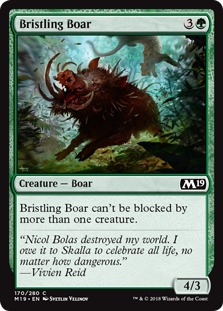
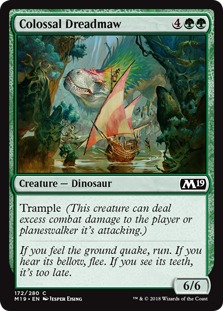
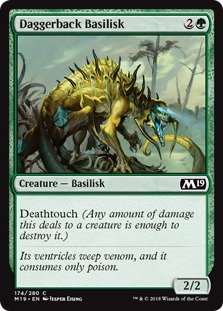

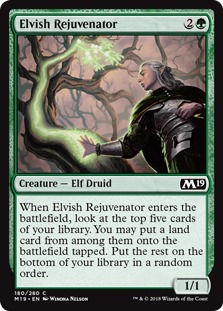


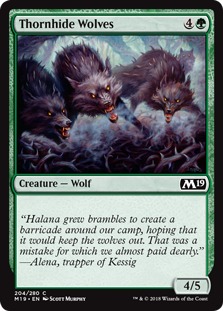

I wanted to highlight what green is bringing to the table in M19. Keep in mind Red commons like Shock, Electrify, and Boggart Brute, Havoc Devils, and Sparktongue Dragon are still well worth drafting in this archetype. But, as you can see Green has a lot of great picks. Druid of the Cowl needs to be taken relatively early, while Elvish Rejuvenator can often be found in the middle of the draft, but both are important for dropping your fatties a turn earlier. Rabid Bite is an excellent card because it is one-way (no fighting required in contrast to what is normally seen in green removal). Titanic Growth is a good combat trick and a great way to outclass Sure Strike for a blowout, but don’t go overboard drafting multiple copies. This is primarily a creature deck and you should be going for 17-18 of them. Daggerback Basilisk may seem unassuming, but it is an extremely important card to get a couple copies of. Basilisk makes Rabid Bite read ‘destroy target creature’ and as I mentioned before it turns Declare Dominance into a 5-for-2 blowout when the board is stalled (Basilisk is good at dissuading attacks as well so you might be surprised at how often this combo works). The rest of the cards here are standard issue green fatties (except Rhox Oracle, who can help gain some card advantage while still presenting 4 power). Don’t take any of these guys early because Green is flush with vanilla fatties (even Centaur Courser, a vanilla 3 mana 3/3, is a fine playable). Finally, Giant Spider is nice to include (3G 2/4 Reach), especially if you are light on removal.
Selesnya (GW) Enchantments
This archetype utilizes enchantments to gain advantages. Like any combo deck, removal shuts it down pretty hard and sometimes you won’t draw your payoff cards. But, when this thing goes off, it GOES OFF. If you catch your opponent without answers, or bait them into using them on your secondary creatures, they are in big trouble.
Uncommon Payoffs



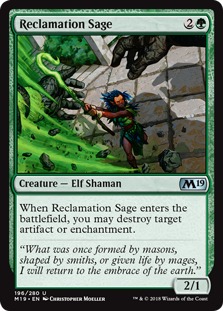

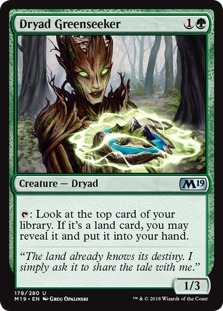
To be clear, these are not the best cards in Green and White, I just wanted to highlight some that haven’t been discussed yet. You should still take Vine Mare first pick, especially in this deck because you are guaranteed to have enchantments for him. Hieromancer’s Cage is totally on theme here, Herald of Faith still rocks, etc.. However, between Satyr Enchanter, Druid of Horns, and Novice Knight, we have some pretty great payoffs in M19 for playing enchantments. Knightly Valor is a pretty nice card in general, but the added value here is nice. Reclamation Sage and Dryad Greenseeker could have made it into my Gruul writeup above as well, being very strong Green picks. Reclamation Sage has a lot of great targets in M19 but primarily it is good for removing the Luminous Bonds or Dwindle your opponent giddily placed on your enchanted creature.
Best Common Enchantments
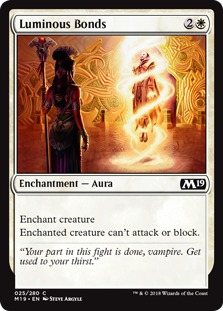


With sufficient payoffs and a couple uncommon enchantments, adding a few of these helps round out the archetype. Luminous Bonds will need to be drafted early but the other two often go very late, so pay attention on your early picks to what will likely wrap. This deck isn’t nearly good enough to force, but if it falls on your lap it has a lot of potential.
Orzhov (BW) Lifegain
Speaking of potential, BW is likely the strongest deck in the format if you see the right cards. There are several bomb uncommons and good options at common, while the overall synergy this archetype can put forth is second to none in M19.
Best Uncommons

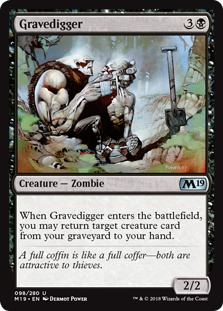

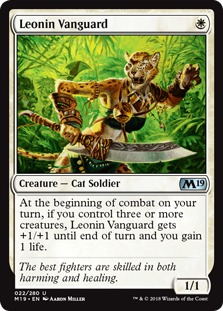



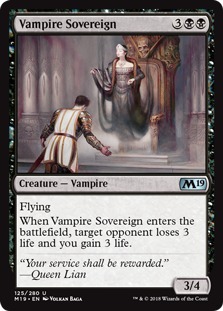
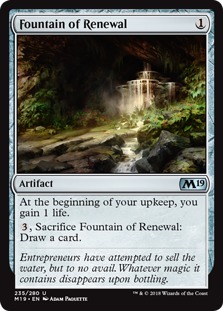
Wow, there is some good stuff here. Ajani’s Pridemate, Regal Bloodlord, and Epicure of Blood (see below) are your key payoffs for gaining life, so make sure you score those before going crazy drafting enablers. Leonin Vanguard and Fountain of Renewal are the most reliable of the enablers, while I would only consider playing Nightmare’s Thirst or Ajani’s Welcome if I am flush with payoffs. Vampire Sovereign and Herald of Faith are bombs and it feels wrong having access to both in one deck. Finally, don’t undervalue Gravedigger (especially in this deck). M19 is a fairly slow format and he can recycle your key combo pieces.
Best Lifegain Commons

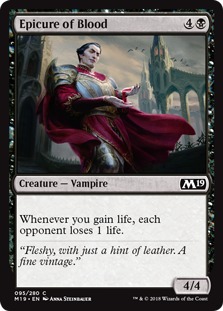

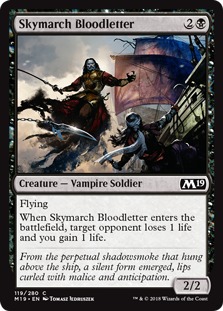
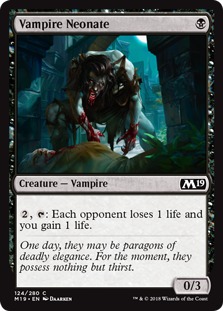

Epicure of Blood is an important payoff card, and 4/4’s hold up really well in M19. If you do end up with multiples of Epicure/Pridemate/Bloodlord Vampire Neonate is a fantastic way to trigger them every turn, and a 0/3 blocker can be very annoying for your opponents. Similarly, Daybreak Chaplain (along with Dwarven Priest) helps prolong the game to set up your combo pieces, so I generally prefer her over Child of Night (but they are similar in power level). Skymarch Bloodletter is a great card that allows you to get more aggressive while still chipping in to the archetype. Finally, Lich’s Caress is a card you want in any Black deck but the added lifegain is a nice touch for this archetype. The great part about this deck is most of the lifegain cards I have shown are ‘filler’ compared to better Black and White commons, so you can find a lot of support late in the draft. This archetype has an extremely high ceiling but I would still caution not to force it unless you see the key payoff cards early.
Dimir (UB) Control
Just like Boros is the only dedicated Aggro archetype, Dimir is the only ‘true’ Control deck (in my opinion). This deck is all about card advantage and managing your opponent’s threats. Good support cards allow Dimir to extend the game by establishing board control. Black contributes removal, lifegain, and discard, while Blue provides card advantage, board control, and flyers.
Best Uncommons


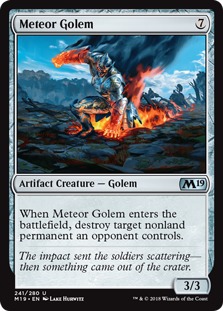





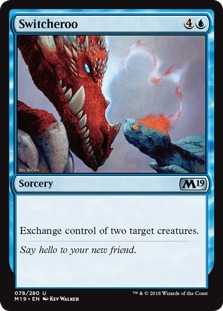
There are some other very good uncommon cards such as Gravedigger or Dispersion Mage, but you have to keep in mind that this is not a creature-based archetype. Not that you shouldn’t draft those cards, but you need to prioritize. Even Sleep is a card I would not take over Vampire Sovereign, Psychic Symbiont, Horizon Scholar, Murder, or Sift. Even though Sleep has the potential to be a complete blowout, in Dimir it is often casted as a fog. The cards I just mentioned are the ones to target, but often you will need to pick up some creatures with impactful abilities, such as Fell Specter, Plague Mare, or Meteor Golem.
Best Commons
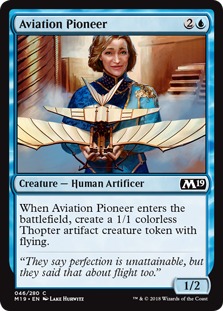
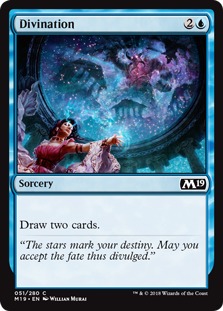



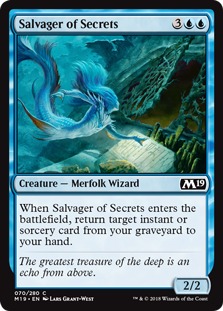



Dimir needs to find a balance between card advantage, defensive creatures, and threats. Creatures like Vampire Neonate, Omenspeaker, and Aviation Pioneer are very important for stalling out the board while adding some value. Most games are going to be won by locking down all of your opponents threats and then chipping away with the likes of Snapping Drake or Vampire Sovereign. Alternatively, if certain cards pop up these colors are good for executing…
The Mill Plan

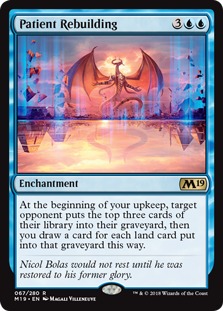

Let me preface this by saying I don’t consider Mill to be a Tier 1 strategy in M19. I am not going to sit here and tell you to draft Millstone. But… it can work. Patient Rebuilding is an absolute bomb if you see it, but more realistically Psychic Corrosion is a card that plays well in this archetype. We are already trying to stall out the board and draw a bunch of cards. Having a couple mill cards can come in very handy in the control mirror as the board becomes even more likely to stall out. Another deck that can support the Mill plan (but not as well) is…
Azorius (UW) Flyers/Artifacts
I may have saved the best for last, as this color combination is extremely strong in M19. The overall power level (especially at common) of Blue and White is probably the highest of all the colors. If you are looking to force an archetype when no bombs are presenting themselves in other colors it would be safest to go with this one. Even if you aren’t able to establish a coherent theme, you can still rely on the high power level of your individual cards.
Best Uncommons



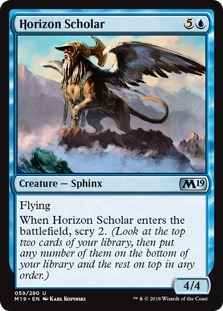
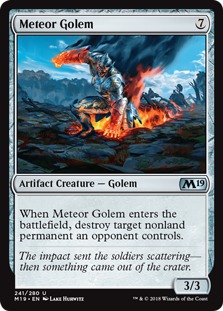
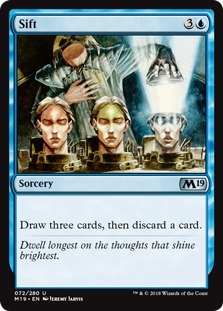
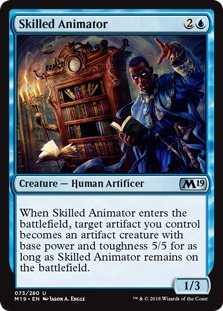
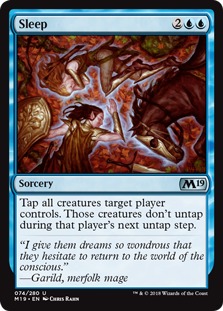
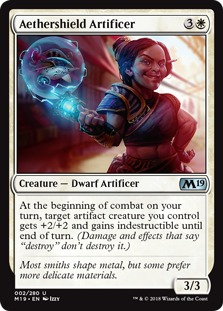
Most of these cards are just generally strong, but there is also an Artifact theme at work here. If you do end up with a few Artifact payoff cards like Aerial Engineer, Skilled Animator, or Aethershield Artificer, uncommon artifacts like Diamond Mare, Fountain of Renewal, or Gargoyle Sentinel get better. It is more then acceptable to ignore the Artifact theme and focus on drafting the strongest cards, however.
Best Commons
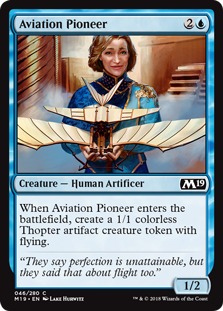
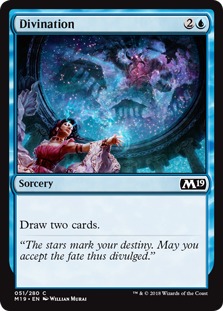






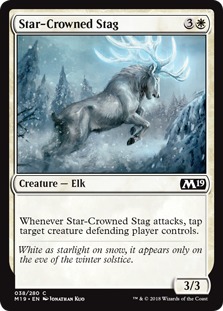

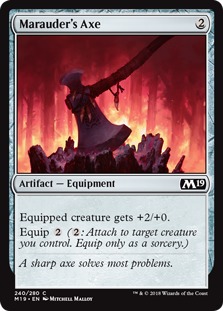

There is a lot to like here, and several more very solid cards I have left out. The Artifact sub theme continues with Gearsmith Guardian (5 mana 5/5 is a very good deal in core set limited) and Skyscanner, as well as cards like Scholar of Stars and playable common artifacts like Marauder’s Axe and Explosive Apparatus. Ultimately, Azorius can be built a lot of different ways and most of them are good. I placed it in the Control section because that is typically how you would play UW, but in M19 it is often more midrange. You can take a controlling stance against more aggressive decks and pull ahead with card advantage. Or sometimes you can turn an artifact into a 5/5 with Skilled Animator on turn 3 and blow out slower decks if they don’t have an answer.
The End, Sample Drafts
That’s all for the guide. I’ve been sitting around Rank #69 Mythic this season (March) but will more than likely play some M19 Drafts to rank up in the April season. If you want to see some of those be sure to follow me on Twitch. Below you will find a few sample drafts that I did in the past to give you an idea of how some of these archetypes come together:
2020 Event – First Draft

This deck illustrates the Elder Dragon splash I mentioned. The enchantment theme doesn’t come through very well but there are a lot of strong individual cards alongside decent removal. I do think 17 Creatures/6 Noncreatures is about where you want to be in this format. I couldn’t resist playing this one in the current season and it is off to a convincing 2-0 start:

M19 Draft #1 – BW Bat Factory (7-2)

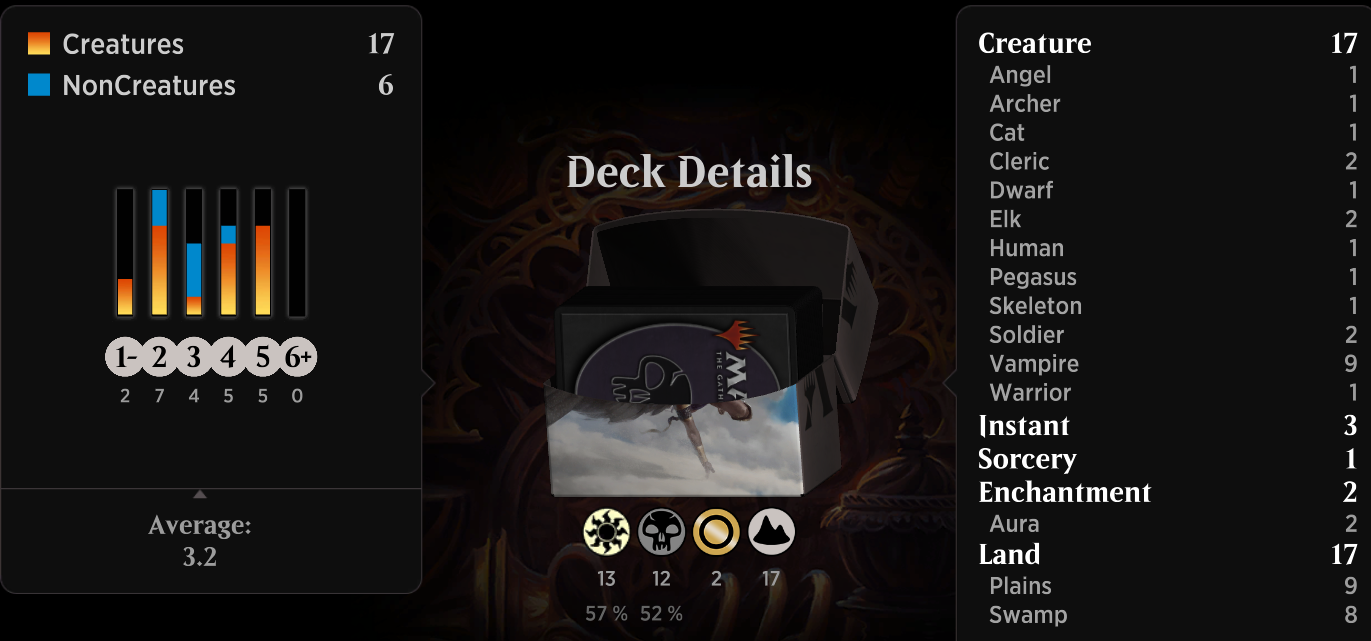
For a deck with zero rares, I was very pleased how it turned out. The ‘curve’ is kind of messy but I’d like to see you cut one of my 5 drops. 17 creatures is almost always where I want to be in a core set draft, and five 2-drop creatures felt about right, especially since nearly all of them had lifelink which stayed relevant even if I drew them late. Plan A was really simple, stabilize the board and then win with a bunch of bats. I was fortunate to have Regal Bloodlord grace me with an appearance most games and execute this plan, but a few of the games I needed to rely on some good old-fashioned evasion.
Regal Bloodlord is obviously the star of this deck, but Epicure of Blood was a solid second option for life gain payoff. Herald of Faith and Vampire Neonate were my star enablers. I am completely sold on Vampire Neonate now. There are a ton of Boros decks running around at the moment (I went 4-0 against that archetype with this deck), and Neonate is great at slowing them down. The best thing about Neonate though is having the ability to make a bat on your opponents turn. Just remember to set a stop before their end step. If you trigger Neonate at end of turn it won’t trigger Bloodlord because he reads ‘At the beginning of each end step.’ That totally cost me a bat once but luckily not the game. Pegasus Courser is another great blocker that can help get aggressive when the time is right, and Luminous Bonds is obviously great.
Child of Night and Daybreak Chaplain are pretty interchangeable, but I really liked 3x Child of Night with 2x Star-Crowned Stag and Pegasus Courser. I was able to get Child of Night in for damage unblocked a lot of times with this deck. Dwarven Priest and Skeleton Archer are two more studs against Boros as they like to flood the board with 2/1 and 3/1 creatures that have a really bad time against this deck.
Invoke and Revitalize were kind of cheeky additions, but they were actually very good! My thought was to add some additional triggers for Regal Bloodlord on my opponents turn to serve as combat tricks. The unexpected life gain also won me at least one game against a Boros deck that thought they had lethal. Macabre Waltz is a card I always want as a one-of, and recycled Herald of Faith and Bloodlord for me at least once apiece. Strangling Spores seems weak, but it is actually good removal in this format. Take advantage of its instant status. A lot of people are running combat tricks which can set up some great 2-for-1’s for it.
M19 Draft #2 – GW Vine Mare (7-1)
Watch Highlight: GW Vine Mare (7-1) from Compulsion02 on www.twitch.tv

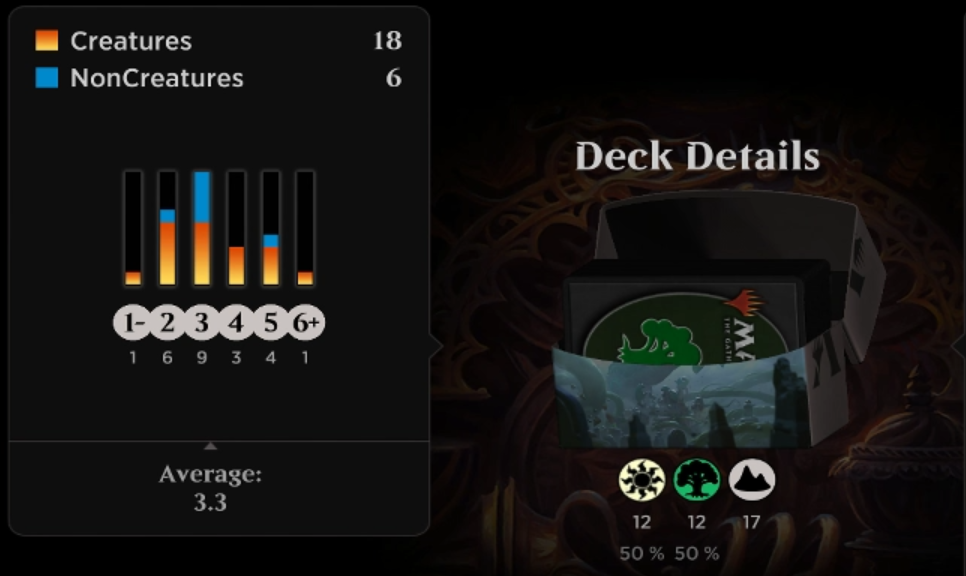
In the current meta flush with Red/White aggro and Blue/Black/White control decks, I was extremely happy with the matchups this deck had. This thing was able to quickly outclass the aggro creatures while still being fast enough to overwhelm the control matchup. Let’s go over some of the key cards below:
While the deck was built around Vine Mare, the most important card here is actually Pegasus Courser. I am convinced Courser is 2nd only to Luminous Bonds at common for White, and especially in a Green deck being able to fly your fatties over is extremely effective. I did win a couple games with the Vine Mare/Oakenform combo which is basically unstoppable. But, I was surprised how good Oakenform can be when you drop it onto a Swiftclaw 3rd turn. Yes it presents a 2-for-1 to your opponent, but if they can’t remove it quickly the game is over. It is definitely a risk/reward play, but it did pay off when I went for it this draft. If Vine Mare is in hand you should absolutely save Oakenform though! I also included the Declare Dominance/Basilisk combo in this deck, which I would highly recommend. Declare Dominance is just great. Even on a non-basilisk creature it can be a nice 2-for-1, and it can win the game at times as an expensive lure. That kind of utility is well worth an early pick, but make sure you have a lot of creatures (this deck had 18) or it could be a dead draw. Mentor didn’t have a ton of targets in this deck, but even if you draw 1-2 cards it’s well worth playing, and Herald of Faith is obviously great.
The deck did include several strong green creatures like Bristling Boar, Rhox Oracle, Thornhide Wolves, and Colossal Dreadmaw. However, I was able to win a lot of games with my low curve cards. As I mentioned earlier, Oreskos Swiftclaw overperformed with 2x Pegasus Courier and Oakenform, while Daggerback Basilisk is a great creature that can Stymie your opponent into holding back, work as a 2 power creature that your opponent doesn’t want to block, or can be a complete blowout with Declare Dominance. I did include Invoke the Divine with the idea that if an opponent 2-for-1’s my creature with Oakenform on it with an enchantment like Luminous Bonds I would have an answer. Invoke is a pretty strong playable in M19 in general since most people are running artifacts or enchantments, but I typically cut it unless I have an additional reason to play it (like in this deck). Take Vengeance and Luminous Bonds were the only true removal spells, but the game plan was to outclass the opponents creatures and if that succeeds removal becomes a lot less important. I did put the Giant Spider here because the main weakness of this deck is to flying, and he was an extra proc for Mentor of the Meek.
M19 Draft #3 – RW Aggro (7-0)


So there are 18 creatures in this deck and four of them are actually two creatures… it’s one of those things that is just so crazy it works. Basically what happened is I hadn’t played Boros yet this season and when I saw Heroic Reinforcements I decided to just force it and see what happened. I was able to collect all of the best White commons besides Luminous Bonds, but with two vanilla three drops (out of only 3) I am still shocked this went all the way to 7-0.
Heroic Reinforcements is clearly the best card in this deck which is completely built around it, and whenever I drew it a complete blowout was the result. Angel of the Dawn, Gallant Cavalry, and Pegasus Courser are the best 3 White commons besides Luminous Bonds in my humble opinion. I did have a sub-theme of Knights with 3x Gallant Cavalry and Valiant Knight, but unfortunately in these matches I didn’t draw them together. Finally, shock was an honorary 3-drop in a deck that desperately needed it. What I mean by that is on turn three I was able to remove a blocker and then lay down another two drop creature.
The falcons should only be played in Boros, but I think Swiftclaw is the best filler 2-drop because he can really punish a slow hand from your opponent. Pyromancer is a close second with the guaranteed damage. Goblin Instigator is generally not very good in M19, but with 2x Vanguard, Angel, Inspired Charge, and Heroic Reinforcements, the extra creature was relevant enough to be worth a pick. Leonin Vanguard is another creature that is generally below average unless you have a way to benefit from the constant lifelink procs (BW decks), but in this deck it was pretty much always a 2/2 for 1 mana which ended up being great.





















